Print History: Seeking print in Madras - Ananda Press
At the dawn of the twentieth century, Madras had emerged as one of the print capitals of India and the centre for Telugu and Tamil printing. A large number of printing presses were owned by Indians who offered a similar range of services. How did Ananda Press stand out?
30 Jun 2022 | By Murali Ranganathan
In 1914, if one wanted to find a printer for a special print job in Madras, all roads led to George Town, the settlement which had mushroomed north of Fort St. George, the seat of the Madras Presidency. Numerous print establishments, newspaper offices and stationery shops could be spotted on a stroll down Popham’s Broadway, the main thoroughfare in town. The city historian, V Sriram notes in Madras Musings that Popham’s Broadway “had much to do with the history of some of the newspapers and periodicals of Madras” even in the nineteenth century. He continues:
It was here that two lithographers, the father and son duo of John and Justinian Gantz, ran the Madras Times in 1859. They also acquired The Spectator which had begun in 1836. In 1868, Charles Lawson and Arthur Cornish, who edited the Madras Times, left it and set up The Madras Mail on Second Line Beach. By the 1920s, the Madras Times and The Madras Mail had merged to become The Mail. Another newspaper that began on Mooker Nallamuthu Street, a cutting off Broadway, was The Indian Express, occupying The Hindu’s first home. The Ananda Vikatan functioned for long from a lovely Indo-Saracenic building on Broadway.…It was also on Broadway that the Brahmavadin, a philosophical magazine, was started in 1895, inspired by Swami Vivekananda.
Resisting the temptation to walk into P Vencatachellum & Co at the start of the Broadway to buy a tin of their world-famous Madras Curry Powder, a print customer could walk into the grand portals of the printing firm, Thompson & Co. Established in 1879 by O Candaswamy Mudaliar, it was managed by his widow. T K Swaminathan, the general manager of the press, would welcome the prospective customer and take him around the composing and machine departments, pointing out that “very chaste designs are issued from this press.” His attention would be drawn to the “very large stock of high-class stationery, suitable alike for business and private purposes,” including the “diaries and calendars which are published every year by the firm … neat in appearance and of convenient size.” He could also visit its bookselling department, where “the stock kept is a comprehensive one, all classes being catered for — from the statesman to the schoolboy.”
If the customer wanted a press of an older vintage, he could take a detour to Second Line Beach and visit the Guardian Press which had been in existence since 1850. Initially established as a speciality press to print the Ramayana in Tamil, the Guardian Press, by 1910, was “appointed by the Government of Madras as agents for the sale of their publications; they subsequently became printers to Messrs. Longmans, Green & Co., to the Corporation of Madras, to the Indian Industrial Conference, and to a number of the leading companies and firms in the Presidency.” They were also the printers of the Guardian Diary, “an everyday vade mecum for the man in the street or office,” which had an annual sales of nearly 20,000 copies.
Finding himself back on Popham’s Broadway around noon, our now-famished print customer, could step into the “well-appointed restaurant” run by Harrison & Co, “where meals are served at short notice, and light refreshments and ices are obtainable from 8 a.m. to 11 p.m. daily, Sundays included, while a string band is in attendance every Wednesday and Saturday evening until 11 o’clock.” He could then continue his quest for print.
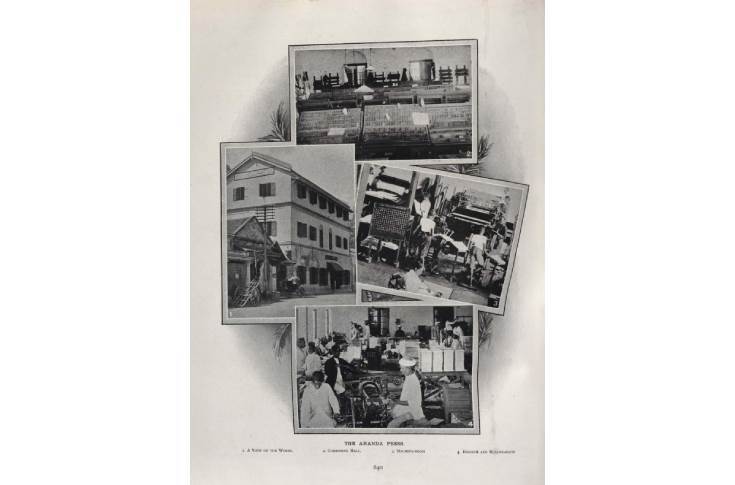
The Ananda Press: 1. A View of the Works; 2. Composing Hall; 3. Machine-Room; 4. Binding and Ruling-Room. Illustration from Southern India, 1914
All these printing options and more are described in Southern India: Its History, People, Commerce and Industrial Resources, an omnibus book published in 1914 soon after the First World War broke out. Compiled by Somerset Playne, who had done similar books in Africa and New Zealand, its “pages are illustrated by a wealth of photographic material, absolutely without precedent in any literary undertaking dealing with the Indian Empire.” Through its text and images, Southern India affords us a peek into the world of Indian printing hundred years ago which no other publication can match.
The illustrations in the book provide an inside view of the printing presses and their employees and vividly captures the workings of the industry a hundred years ago. The images of the composing rooms and machine rooms which housed the printing presses harken back to a period when manual labour was the main motive force of print. Unlike Playne’s other Indian books, Southern India is particularly focussed on the printing sector in its survey of industries.
As our imaginary print client wends his way down Broadway post-lunch, he would chance upon other purveyors of print surveyed by Southern India including the Madras Stationery Mart. On enquiring inside about job printing options, he would be directed to visit the Ananda Press at Loane Square, just around the corner from the Madras Stationery Mart.
Beginnings of the Ananda Press
The Ananda Press was established under the business name of R Venkateshwar & Co in 1891. Its proprietor in 1914 was V. Ranganatham Chetty, who was well known in the print trade. Though it had a very modest beginning, by 1914, it was one of the leading print establishments of the city. The retail arm of R Venkateshwar & Co was Madras Stationery Mart and it also enjoyed an excellent reputation.
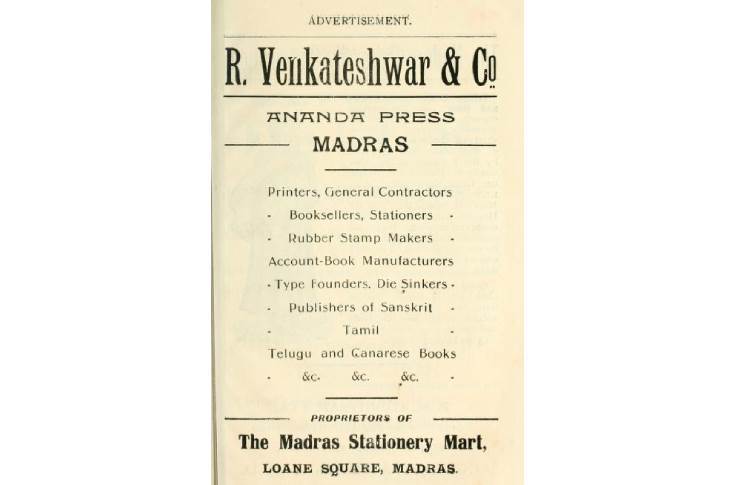
Advertisement for Ananda Press in Indian Biographical Dictionary, 1915
Chetty was born in 1879 to Venkatakrishnamma Chetty, a merchant belonging to the Arya Vysya community. Not much is known about his early life and education except that he studied at Pachaiyappa’s College. He seems to have joined the family printing business while still in college. “In his early days,” according to Southern India, “he had a thoroughly practical training in the compositors’-room, as well as in the retail shop, and it is this experience which enables him to control the mass of detail work which is a portion of each day’s programme.” Writing in Southern India, Somerset Playne notes that:
The concern has grown from a modest beginning to one of the leading establishments of its kind in the city, and the proprietor now finds employment for about 220 assistants. The buildings are in two blocks; the retail department, in Popham’s Broadway, known as the Madras Stationery Mart, which is in charge of Mr. Ranganatham Chetty’s nephew, Mr. V. S. Ramachandra Chetty…; while the printing works, known as the “Ananda Press” and supervised by another nephew, Mr. V. A. Keshub Chandra, are situated in a very fine three-storied structure in Loane Square, which is right in the heart of the busiest portion of the principal banking, government, municipal, and mercantile offices of the city.
The plant in the works consists of a number of large modern machines, six of which are for general printing, five for jobbing orders, and five for type-casting. Busy hands may be seen manufacturing and binding books, stereo-typing, die-sinking, copper-plate printing, machine-ruling, and preparing rubber stamps.
The Ananda Press was already known for quality printing in Tamil and Telugu and had printed numerous classical texts. Some of its editions are still acknowledged as standard and reliable editions by scholars. It also had executed numerous print contracts. “The proprietor does a considerable portion of the printing for the Madras and Southern Mahratta Railway, and he is always prepared to enter into contracts for general or artistic work.”
The Madras Stationery Mart, perhaps inspired by the Bombay Stationery Mart, contained “a well-selected assortment of commercial and fancy writing-papers, account-books, pencils, pens, mathematical instruments, cyclostyle duplicating apparatus, cabinets, and a general stock of sundries.” It was also a bookshop: “The show-cases in the Broadway shop contain a grand selection of books, which are published in nearly all of the Indian languages as well as in English, and these comprise historical and geographical volumes for students, in addition to literature of a higher kind for the general reader.”
The man and his legacy
According to Playne, “One of the secrets of the success of the Ananda Press is that only expert workmen are employed, and as every process is subject to the keen and practical supervision of the owner, it will be understood that customers can always rely upon efficiency, combined with the highest quality of workmanship.” Vemuru Ranganatham Chetty, on the strength of his multifarious printing activities, came to be recognised as one of the leading citizens of Madras. And like many of them, his charities were also widespread.
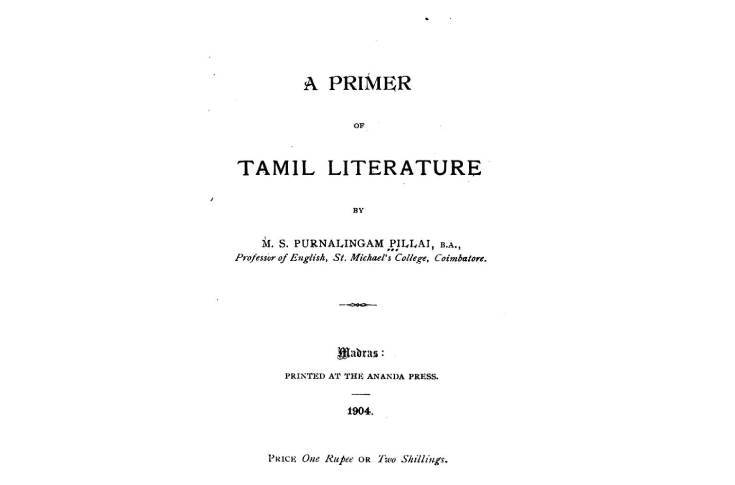
Imprint from the Ananda Press
Chetty was active in the management of temple trusts and also built a hostel – Sree Venkateswara Students Hostel – for outstation students on Triplicane High Road in 1918. Built in an Indo-Saracenic style, the hostel continues to host aspiring graduates. In recognition of his activities, his name figured in the honours list for 1923 issued by the Government of India. And he was henceforth known as Rao Bahadur Vemuru Ranganatham Chetty.
As the print industry continued to modernise in the mid-twentieth century, printing firms of a certain vintage like Ananda Press found it difficult to keep pace with the latest technology. The Ananda Press continued to print books at least until the 1940s and seems to have wound up its business activities around the same time as Chetty’s death. Writing in The Hindu in 2012, historian V Sriram notes that “Ranganatham Chetty passed away in the 1950s. Much of his wealth went to a charity bearing his name. His alma mater received endowments. The Government Museum was another beneficiary and still conducts an annual lecture in his memory. His residence, Lakshmi Sadanam on South Mada Street in Triplicane, is now a venue for public events. The trustees of his Charity built a ladies hostel later. Clearly, the good that he did has outlived him.”
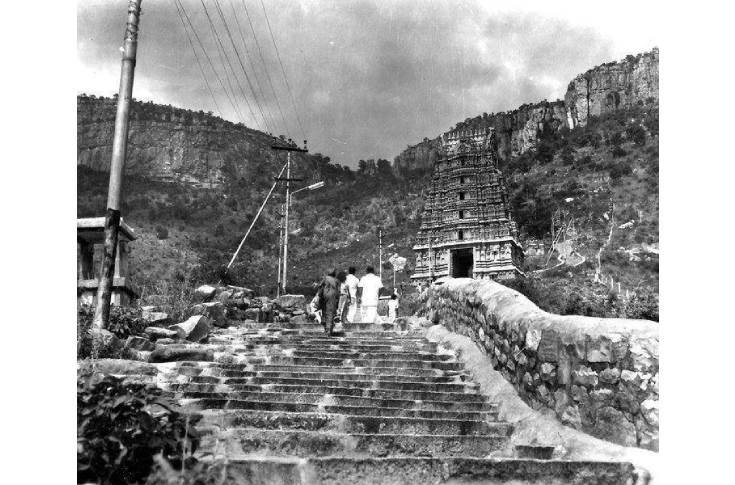
Illustration from A History of the Holy Shrine of Sri Venkatesa in Tirupati by S Krishnasvami Aiyangar (Ananda Press, 1939)
Sources
- Southern India: Its History, People, Commerce and Industrial Resources. Compiled by Somerset Playne. Edited by Arnold Wright. London: The Foreign and Colonial Compiling and Publishing Company, 1914.
- ‘A printer’s philanthropy.’ V Sriram. The Hindu (6 November 2012)
- ‘Breathing the air of Broadway.’ V Sriram. Madras Musings (Vol 20, no. 19, 16-31 January 2011).


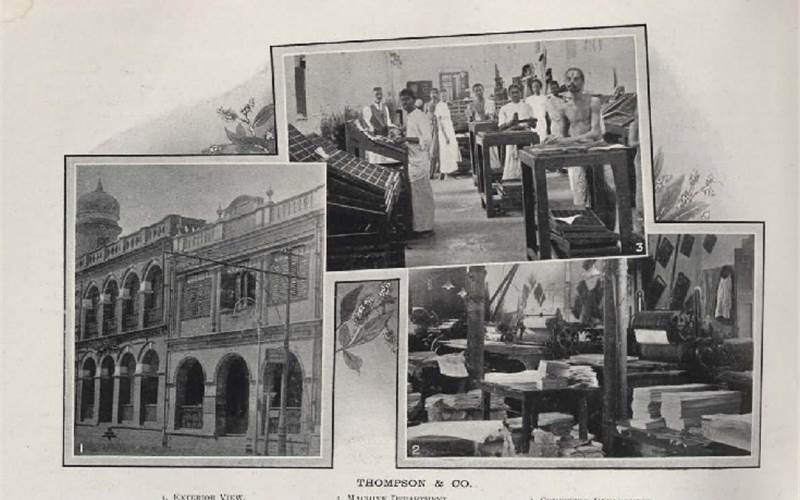









 See All
See All